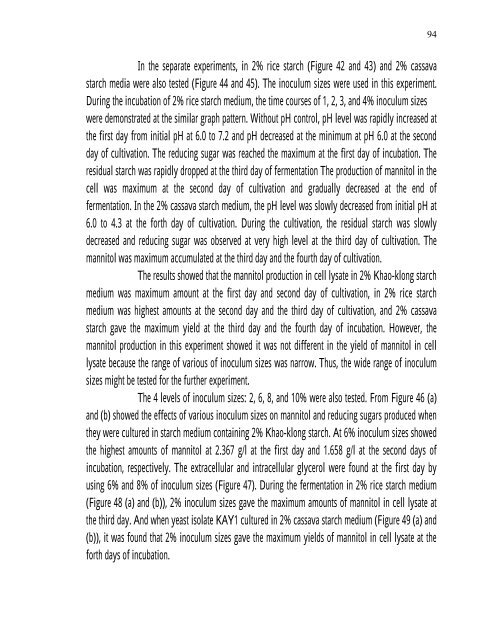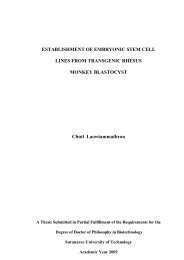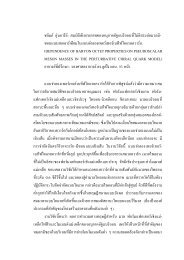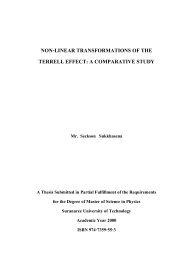PRODUCTION Of NUTRIENT SOURCES FOR RHIZOBIUM
PRODUCTION Of NUTRIENT SOURCES FOR RHIZOBIUM
PRODUCTION Of NUTRIENT SOURCES FOR RHIZOBIUM
You also want an ePaper? Increase the reach of your titles
YUMPU automatically turns print PDFs into web optimized ePapers that Google loves.
In the separate experiments, in 2% rice starch (Figure 42 and 43) and 2% cassava<br />
starch media were also tested (Figure 44 and 45). The inoculum sizes were used in this experiment.<br />
During the incubation of 2% rice starch medium, the time courses of 1, 2, 3, and 4% inoculum sizes<br />
were demonstrated at the similar graph pattern. Without pH control, pH level was rapidly increased at<br />
the first day from initial pH at 6.0 to 7.2 and pH decreased at the minimum at pH 6.0 at the second<br />
day of cultivation. The reducing sugar was reached the maximum at the first day of incubation. The<br />
residual starch was rapidly dropped at the third day of fermentation The production of mannitol in the<br />
cell was maximum at the second day of cultivation and gradually decreased at the end of<br />
fermentation. In the 2% cassava starch medium, the pH level was slowly decreased from initial pH at<br />
6.0 to 4.3 at the forth day of cultivation. During the cultivation, the residual starch was slowly<br />
decreased and reducing sugar was observed at very high level at the third day of cultivation. The<br />
mannitol was maximum accumulated at the third day and the fourth day of cultivation.<br />
The results showed that the mannitol production in cell lysate in 2% Khao-klong starch<br />
medium was maximum amount at the first day and second day of cultivation, in 2% rice starch<br />
medium was highest amounts at the second day and the third day of cultivation, and 2% cassava<br />
starch gave the maximum yield at the third day and the fourth day of incubation. However, the<br />
mannitol production in this experiment showed it was not different in the yield of mannitol in cell<br />
lysate because the range of various of inoculum sizes was narrow. Thus, the wide range of inoculum<br />
sizes might be tested for the further experiment.<br />
The 4 levels of inoculum sizes: 2, 6, 8, and 10% were also tested. From Figure 46 (a)<br />
and (b) showed the effects of various inoculum sizes on mannitol and reducing sugars produced when<br />
they were cultured in starch medium containing 2% Khao-klong starch. At 6% inoculum sizes showed<br />
the highest amounts of mannitol at 2.367 g/l at the first day and 1.658 g/l at the second days of<br />
incubation, respectively. The extracellular and intracellular glycerol were found at the first day by<br />
using 6% and 8% of inoculum sizes (Figure 47). During the fermentation in 2% rice starch medium<br />
(Figure 48 (a) and (b)), 2% inoculum sizes gave the maximum amounts of mannitol in cell lysate at<br />
the third day. And when yeast isolate KAY1 cultured in 2% cassava starch medium (Figure 49 (a) and<br />
(b)), it was found that 2% inoculum sizes gave the maximum yields of mannitol in cell lysate at the<br />
forth days of incubation.<br />
��






